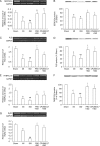CPU86017, a berberine derivative, attenuates cardiac failure through normalizing calcium leakage and downregulated phospholamban and exerting antioxidant activity
- PMID: 20139899
- PMCID: PMC4002834
- DOI: 10.1038/aps.2009.180
CPU86017, a berberine derivative, attenuates cardiac failure through normalizing calcium leakage and downregulated phospholamban and exerting antioxidant activity
Abstract
Aim: To investigate whether CPU86017, a berberine derivative, attenuates heart failure by blocking calcium influx and exerting its antioxidant activity.
Methods: Myocardial infarction was induced in male Sprague-Dawley rats for 17 d followed by isoproterenol (ISO) (5 mg/kg, sc) treatment for 5 d to reduce cardiac function. The rats were divided into 5 groups: sham operation, myocardial infarction (MI), MI plus ISO, and co-treated (in mg/kg, po) with either propranolol (PRO, 10) or CPU86017 (80). Hemodynamic measurements were conducted, and measurements of the redox system, calcium handling proteins and endothelin (ET) system in vivo were done. Furthermore, calcium flux studies and PLB immunocytochemistry were conducted in vitro.
Results: Compared to sham operation, HF was evident following MI and further worsened by ISO treatment. This occurred in parallel with downregulated mRNA and protein production of SERCA2a, PLB, and FKBP12.6, and was associated with upregulation of preproET-1, endothelin converting enzyme, and PKA mRNA production in the myocardium in vivo. Calcium leakage was induced by ISO treatment of isolated beating myocytes in vitro. These changes were attenuated by treatment with either PRO or CPU86017. PLB fluorescence in myocytes was downregulated by ISO treatment, and was relieved significantly by treatment with antioxidant aminoguanidine, ascorbic acid or CPU86017 in vitro.
Conclusion: HF, calcium leakage, downregulated PLB, FKBP12.6, SERCA2a production, and upregulated PKA were caused by ISO treatment, and were abolished by CPU86017 treatment. The beneficial effects of CPU86017 are attributable to its antioxidant and calcium influx blocking effects.
Figures






Similar articles
-
Upregulation of leptin pathway correlates with abnormal expression of SERCA2a, phospholamban and the endothelin pathway in heart failure and reversal by CPU86017.Naunyn Schmiedebergs Arch Pharmacol. 2007 Mar;375(1):39-49. doi: 10.1007/s00210-007-0134-1. Epub 2007 Feb 8. Naunyn Schmiedebergs Arch Pharmacol. 2007. PMID: 17287947
-
Abrupt changes in FKBP12.6 and SERCA2a expression contribute to sudden occurrence of ventricular fibrillation on reperfusion and are prevented by CPU86017.Acta Pharmacol Sin. 2007 Jun;28(6):773-82. doi: 10.1111/j.1745-7254.2007.00580.x. Acta Pharmacol Sin. 2007. PMID: 17506935
-
Reversal of isoproterenol-induced downregulation of phospholamban and FKBP12.6 by CPU0213-mediated antagonism of endothelin receptors.Acta Pharmacol Sin. 2007 Nov;28(11):1746-54. doi: 10.1111/j.1745-7254.2007.00650.x. Acta Pharmacol Sin. 2007. PMID: 17959025
-
CPU86017: a novel Class III antiarrhythmic agent with multiple actions at ion channels.Cardiovasc Drug Rev. 2006 Summer;24(2):101-15. doi: 10.1111/j.1527-3466.2006.00101.x. Cardiovasc Drug Rev. 2006. PMID: 16961724 Review.
-
Regulation of phospholamban and troponin-I phosphorylation in the intact rat cardiomyocytes by adrenergic and cholinergic stimuli: roles of cyclic nucleotides, calcium, protein kinases and phosphatases and depolarization.Mol Cell Biochem. 1995 Aug-Sep;149-150:103-26. doi: 10.1007/BF01076569. Mol Cell Biochem. 1995. PMID: 8569720 Review.
Cited by
-
The Cardiac Lipidome in Models of Cardiovascular Disease.Metabolites. 2020 Jun 17;10(6):254. doi: 10.3390/metabo10060254. Metabolites. 2020. PMID: 32560541 Free PMC article. Review.
-
Raisanberine protected pulmonary arterial rings and cardiac myocytes of rats against hypoxia injury by suppressing NADPH oxidase and calcium influx.Acta Pharmacol Sin. 2012 May;33(5):625-34. doi: 10.1038/aps.2012.7. Acta Pharmacol Sin. 2012. PMID: 22555370 Free PMC article.
-
Research Progress on Natural Products' Therapeutic Effects on Atrial Fibrillation by Regulating Ion Channels.Cardiovasc Ther. 2022 Mar 22;2022:4559809. doi: 10.1155/2022/4559809. eCollection 2022. Cardiovasc Ther. 2022. PMID: 35387267 Free PMC article. Review.
-
Role of berberine in Alzheimer's disease.Neuropsychiatr Dis Treat. 2016 Oct 3;12:2509-2520. doi: 10.2147/NDT.S114846. eCollection 2016. Neuropsychiatr Dis Treat. 2016. PMID: 27757035 Free PMC article. Review.
-
Effects of histidine and vitamin C on isoproterenol-induced acute myocardial infarction in rats.Vet Res Forum. 2016 Winter;7(1):47-54. Epub 2016 Mar 15. Vet Res Forum. 2016. PMID: 27226887 Free PMC article.
References
-
- Lehnart SE, Wehrens XH, Kushnir A, Marks AR. Cardiac ryanodine receptor function and regulation in heart disease. Ann NY Acad Sci. 2004;1015:144–59. - PubMed
-
- Lehnart SE. Novel targets for treating heart and muscle disease: stabilizing ryanodine receptors and preventing intracellular calcium leak. Curr Opin Pharmacol. 2007;7:225–32. - PubMed
-
- Reiken S, Gaburjakova M, Guatimosim S, Gomez AM, D'Armiento J, Burkhoff D, et al. Protein kinase A phosphorylation of the cardiac calcium release channel (ryanodine receptor) in normal and failing hearts. Role of phosphatases and response to isoproterenol. J Biol Chem. 2003;278:444–53. - PubMed
Publication types
MeSH terms
Substances
LinkOut - more resources
Full Text Sources
Medical
Research Materials
Miscellaneous

